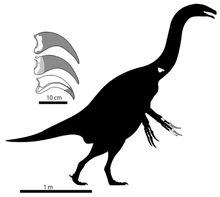Paralitherizinosaurus is an extinct genus of therizinosaurid dinosaur from the Late Cretaceous Osoushinai Formation of Hokkaido, Japan. The genus contains a single species, P. japonicus, known from a partial right hand and cervical vertebra. Paralitherizinosaurus represents the youngest therizinosaur known from Japan.[1]
| Paralitherizinosaurus Temporal range:
Late Cretaceous, | |
|---|---|

| |
| Known fossil material | |
| Scientific classification | |
| Domain: | Eukaryota |
| Kingdom: | Animalia |
| Phylum: | Chordata |
| Clade: | Dinosauria |
| Clade: | Saurischia |
| Clade: | Theropoda |
| Family: | †Therizinosauridae |
| Genus: | †Paralitherizinosaurus Kobayashi et al., 2022 |
| Species: | †P. japonicus
|
| Binomial name | |
| †Paralitherizinosaurus japonicus Kobayashi et al., 2022
| |
Discovery and naming
editThe Paralitherizinosaurus holotype specimen, NMV-52, was discovered in September 2000 in layers of the Osoushinai Formation (Yezo Group) in Nakagawa, Hokkaido, Japan, which dates to the early Campanian age of the late Cretaceous period. The specimen consists of a partial cervical vertebra and the metacarpal I, proximal ends of unguals I and II, and nearly complete ungual III of the right hand.[1][2]
Some of these remains were first described by Murakami et al. in 2008 as belonging to an indeterminate genus of maniraptoran theropod, possibly with therizinosauroid affinities.[2] In 2022, Kobayashi et al. described Paralitherizinosaurus as a new genus and species of therizinosaurid making it the third therizinosaur found in Japan.[3] This taxon represents the first named therizinosaur from Japan, with two other unnamed specimens being known. The generic name, "Paralitherizinosaurus", combines the Greek words "paralos", meaning "tidal" and "therizo", meaning "scythe", and the Latin "sauros", meaning "lizard". The specific name, "japonicus", refers to the taxon's discovery in Japan.[1]
Classification
editIn their phylogenetic analyses, Kobayashi et al. (2022) recovered Paralitherizinosaurus as a member of a clade containing Therizinosaurus, Suzhousaurus, and an unnamed therizinosaurid from the Bissekty Formation of Uzbekistan. The cladogram below displays the results of their phylogenetic analyses.[1]
| Therizinosauria |
| ||||||||||||||||||||||||||||||||||||||||||||||||||||||||||||||||||||||||||||||
References
edit- ^ a b c d Kobayashi, Yoshitsugu; Takasaki, Ryuji; Fiorillo, Anthony R.; Chinzorig, Tsogtbaatar; Hikida, Yoshinori (2022). "New therizinosaurid dinosaur from the marine Osoushinai Formation (Upper Cretaceous, Japan) provides insight for function and evolution of therizinosaur claws". Scientific Reports. 12 (7207). doi:10.1038/s41598-022-11063-5. ISSN 2045-2322. PMC 9065154.
- ^ a b Murakami, Mizuki; Hirayama, Ren; Hikida, Yoshinori; Hirano, Hiromichi (2008). "A theropod dinosaur (Saurischia: Maniraptora) from the Upper Cretaceous Yezo Group of Hokkaido, Northern Japan". Paleontological Research. 12 (4): 421–425. doi:10.2517/prpsj.12.421. ISSN 1342-8144. S2CID 128744799.
- ^ "New Dinosaur Species Identified in Japan | Sci-News.com". Breaking Science News | Sci-News.com. Retrieved 25 May 2022.
External links
edit- Media related to Paralitherizinosaurus at Wikimedia Commons